






































We have had a mixture of weather recently, with cold bright sunny days, as well as some breezy wet days. What do you think our Spring and summer will bring us this year? Last summer was pretty good, so I am ever hopeful (as always) that once again we will be able to bask in the sun and enjoy some alfresco dining. For now, we can marvel at the snowdrops (my all-time favourites), the bluebells, tulips and golden / white delightful daffodils. Gorgeous.
Do you have a spring clean to do? Do you want to change the décor? We did a spot of redecorating ourselves this week. Do you need a carpet cleaned, a tidy of the garden, a new blind for the kitchen, or new windows? Well, our wonderful advertisers here can help you! Take a look through your local magazine and see who you can call to ask for advice and get them to come to you or visit them at their place of work and then let them do the work for you. That is what they are here for.
If you have a summer fete coming up, a barn dance, a community picnic in the garden, a local sing-song or amateur play to perform, please let us know as we can promote these for you for free. Anything which is local and has the purpose of bringing people together we want to support. Let’s get to know our friends and neighbours and create some social time. It makes all that working so much easier and gives us things to look forward to. Happy March to you all!
Debbie, Stephen & all of us here at Modern Magazines

DISCLAIMER: Whilst every care has been taken to ensure the data in this publication is accurate, the publisher cannot accept any liability to any party to loss or damaged caused by errors or omissions resulting from negligence, accident or any other cause.











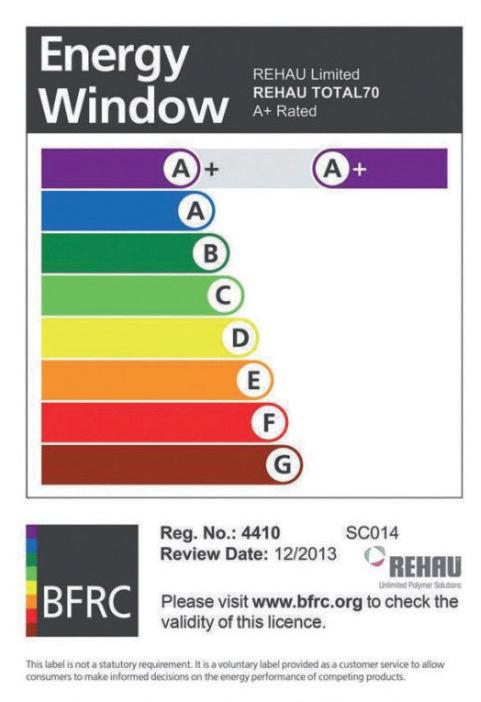


Residents and local communities are being invited to apply for a free street party licence to mark the Coronation of His Majesty King Charles III and Her Majesty The Queen Consort.
The UK will celebrate the Coronation of King Charles III with a three-day bank holiday weekend from Saturday 6 May to Monday 8 May 2023.

The Coronation will take place on the morning of Saturday 6 May at Westminster Abbey, and on Sunday 7 May Coronation Big Lunches will bring communities together with a special Coronation Concert at Windsor Castle.
On the 8 May, The Big Help Out, will provide an opportunity to reflect on the legacy of His Majesty’s service and showcase the impact of volunteering within communities.
To help residents commemorate the Coronation, BCP Council is waiving the usual administration fee for street party road closures. Street parties are a great opportunity for communities to come together, usually organised by groups of residents who get together and to celebrate with their neighbours, friends and families.

For anyone wishing to hold a street party over the extended bank holiday weekend, the Council asks that applications are submitted by Friday
24 March 2023.
Councillor Beverley Dunlop, Portfolio holder for Tourism, Culture and Vibrant Places said,
“The King’s Coronation marks a special time in our history, and it is an opportunity for us to come together again to celebrate.”
“We want to make it easy for local residents and communities to organise street parties. To celebrate this special occasion, we have waived the fee to close residential roads and made the process easy to encourage as many residents as possible to join in.”
“I would urge anyone thinking of holding a street party to visit our website now and complete the application form to get the ball rolling, leaving you plenty of time to plan the fun with your neighbours.”
The Big Screens will be in position over the weekend in Bournemouth, Christchurch and Poole broadcasting the national events and further local events will be announced in the coming days.
To find out more about hosting a street party and celebrating the coronation visit our website: www.bcpcouncil.gov.uk



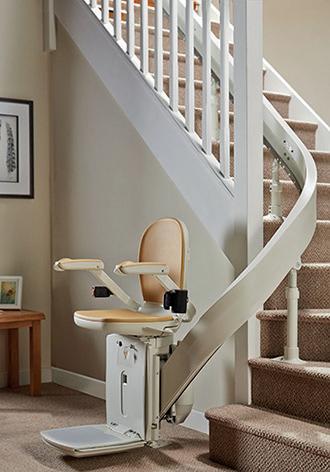
Topsie Gillingham, part of the Tops Day Nurseries chain, located at The Stone House, High Street, have spent the last week promoting the importance of reading in the Early Years. Topsie Gillingham invited local Mayor, Cllr Sharon Cullingford to read a story to the children at the nursery, as part of the week.
Tops Day Nurseries, a nursery chain with over 30 nurseries across the Southwest, actively encourage reading in the Early Years and understand the value of reading at a young age. Cllr Sharon Cullingford was eager to get involved to help spread this important message throughout the community.
During her visit, the local Mayor of Gillingham read ‘The Tiger Who Came to Tea’. The children thoroughly enjoyed it and even had a chance to look at the Mayors ‘Civic regalia’.


National Storytelling Week takes place every year and is a celebration
of the power of sharing stories. Stories teach us about the world, they allow us to step into someone else’s shoes and feel empathy, they help us to relax and can help develop essential literacy skills.
Cllr Sharon Cullingford, Mayor of Gillingham, said:
“Thank-you for asking me to join in with your Book Week, what a delightful time I had, reading ‘The Tiger Who Came to Tea’ the children were so well behaved.At Topsie, you pride yourselves on being an inspirational nursery in which children’s imaginations can run wild. You have introduced attractive and stimulating areas throughout, which maximizes the developmental experiences for the children who attend. Congratulations to all the lovely friendly staff at Topsie for making me so welcome and for developing such a fantastic nursery, you are an amazing Asset to the Town of Gillingham”.
Tops Day Nurseries have over 30 nurseries across the South and Southwest. The eco-sustainable childcare provider offers Early Education and Care for children aged 3 months to school age, as well as before, after-school and holiday clubs for children up to 11.
Here at United Fencing Supplies we specialise in all types of fencing from domestic to industrial.

We stock a full range of timber fencing products including:



• Picket Fencing
• Closeboard Fencing
• Trellis and Overlap
• Closeboard Panels
We manufacture all of our own panels, trellis and gates so if you have any bespoke requirements please don’t hesitate to contact us.
With over 25 years’ experience we are confident that United Fencing Supplies is the right choice for your garden project.















Via a galaxy far, far away, film star John Boyega is back within a few miles of where it all began - Peckham’s hottest property has been subtly talking up an Attack the Block sequel, something which reveals a few things about the 30-year-old social justice champion.


For many cinemagoers, John Boyega’s unveiling to mass popular culture was in the opening shot of the very first teaser trailer for 2015’s Star Wars: The Force Awakens, which attracted a recordbreaking 58 million YouTube views in its first week.
Past that, Boyega has strengthened his allegiance to the Star Wars brand in almost every way possible, as well as finding time to tread the boards, effectively making a
return to where his acting career started, describing his 2017 appearance in Woyzeck as “like riding a bike”.
“You’re on the stage and suddenly the lights are on and there’s an audience either clapping or throwing tomatoes at you,” he begins. “You have to adjust from being on a film set as there’s only one take!”
Boyega now looks to take that reconnection even further with the much talked-about return of Attack the Block, which came before Star Wars, albeit to a much more limited audience. The original 2011 sleeper hit became a cult film and launched both his and director Joe Cornish’s careers.
It’s therefore with some element of sentimentality, perhaps, that the multi-millionaire actor accepts the invitation to do it all again, at a time when his public profile suggests he should be doing something more status-driven.

“There is a romantic element to this, I don’t deny it,” he says. “You always want to reignite how the past feels, and it
gives you some perspective and appreciation of how far you have of come.
“No-one is doing this just for kicks. We are serious and we want to create something that isn’t just part of a sentimental journey. And it will be good. Better than good!”
Boyega’s return to the council estate also belies a growing reputation that he has become a stereotypical mouthpiece for a minority. “The things that matter to me – racism, equality, fairness – have mattered to me all my life,” he explains.
“I have never removed myself from who I am or what I stand for. What I do think is that the media are very good at painting you in one light, and that can be the go-to headline for everything you do.
“I don’t want to be that person,” he admits. “Sure, I want to champion equality, but that is not everything I stand by and stand for, and I think most people who know me, know that.”





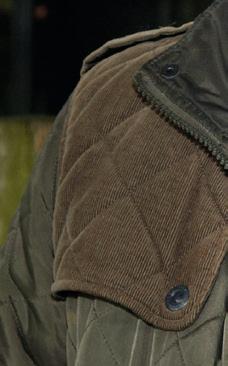


Designer, writer and television presenter, Kevin McCloud leapt into our consciousness with his vastly successful Grand Designs show on Channel 4. This month, the affable architectural business owner talks about his favourite room in the house.


I often get asked what I believe is the most important room in any building and my answer is always the same – it’s the toilet!

Now then, I know that’s not the most glamorous of answers, but think about it - you can make a house or a building with any number of rooms; you could create a home with no lightbulbs and perhaps not even a single window; yet without basic sanitation you could never remain there.
Without running water, you have almost no chance of survival without risking poor health, disease and, ultimately, death.
I’m seen the evidence of this, too. I’ve visited places in the world where running water and basic sanitation doesn’t exist; where the absence of those two things creates utter chaos and would eventually bring about the end of civilisation as we know it.
The point of all this is that in this world of ambition and desire, and in our pursuit of homely perfection, we can very quickly and very easily lose sight of the true basic necessities that enable us to evolve and survive as human beings.
It’s for that reason that someone moving into a shoebox studio flat in a grubby backstreet in a dead-end town can actually feel like they have achieved something monumentally big…
and they would be absolutely correct in that notion.
When you have somewhere that offers sanitisation, somewhere to eat, somewhere to sleep – you essentially have created the building blocks preservation of life. That’s tremendously exciting, very special and, rightly, the most rewarding feeling you can have.
In the coming year, we will all dream and plan and design… and do all those other things as far as the perceived improvement of our homes is concerned, and of course that’s the way we are as people – we are almost always forwardthinking and aspirational.
However, sometimes, it really is rewarding to take a step back – to look not at what you don’t have, but what you do have. It’s to say, ‘I am here, and I am covered’.
To have the basic necessities in life is actually 99% of survival and success… everything else on top is just decoration.























I am a 3 year old Beagle Cross. I have come from the pound and my history is limited. I have clearly lived in a home before and have all the social graces. I walk quite well on the lead but would benefit from some further training. I like people, especially if they play ball with me. I have a selection of toys which I love to play with in my room. I need a lot of activity as I am a clever and energetic girl. I enjoy meeting other dogs on my walks and had a friend here who I played with on the field. I am looking for an active home – I’m a busy beagle and typical of my breed.

If you are able to offer me or one of my lovely friends a forever home or a foster home
Please contact our office on: Tel: 01202 875000
Email: admin@waggytails.org.uk
or visit our website : www.waggytails.org.uk
We also have lots of other dogs looking for their forever homes.
Waggy Tails Rescue are in need of more foster homes. If you are at home most of the time, have a secure garden an experienced with
dogs then please give us a ring and discuss fostering for us. It is a very rewarding experience and enables us to continue helping these dogs.
(No children under 10 in the house please.)
Waggy Tails Rescue is a registered charity based in Dorset, we rescue and rehome dogs that have been abandoned, neglected or otherwise in need of a new home. We also find homes for other small furries that may be in our care, so to find out more you can contact us on the number above or send donations or letters to:
Waggy Tails Rescue

Helen’s House
143 Magna Road
Wimborne
BH21 3AW
Thank you for supporting us!









Coping with the scourge of insomnia.
The effect of insomnia can be tiredness, irritation, an inability to perform even simple tasks, plus feelings of confusion, depression and despondency.
Yet by managing sleep routine, it’s possible to temper the effects of insomnia.

Creating and sticking to a solid night-time routine is essential for managing insomnia.
This should begin with a set timeframe for going to bed, encompassing a gradual but planned wind-down as the evening progresses.
Waking up at approximately the same time each day is also important – sleeping in too late can mean the body isn’t tired enough to embrace sleep that night.


Reading a book or taking a bath will help your body and brain to relax during the process of calming down towards sleep. Peaceful activities prior to bedtime will positively enhance
your chance of falling asleep.
In contrast, it’s not wise to eat or drink anything substantial before retiring to bed. Smoking and consumption of alcohol or caffeine are a bad idea, as is the use of devices that emit blue light, such as televisions, smartphones or tablets. These will all prolong your time awake.
Ensure your bedroom is fully dark, quiet and calm when you go climb into bed. This will give you a head start in overcoming the battle against sleeplessness. Having fewer things to irritate or distract you is an important factor – even the ticking of a clock can keep brain function at levels that prevent it from relaxing.
In contrast, some insomniacs feel more assured with the presence of background
noise. Technology can play an important role in this, with everything from full-on podcasts to pre-recorded sounds such as crackling fires, thunderstorms and white noise, all of which are proven to help some drift off. It may well be a case of trial and error in discovering what works best for you.
While sleep is vital for the body to regenerate and recover from the day’s exertions, so too does it rely on having enough activity to feel it needs to drop into unconsciousness in order to rest and recover.
That means the more active you are during the day – physically and mentally – the more energy you will use and, in turn, the more you will need to recuperate.
Night-time convalescence is the perfect antidote to a tired and weary physique, so be active enough that the suggestion of sleep is one your brain cannot resist.













For March, four books that will entertain, engage and heal the soul.



When William meets Julia Padavano, a lively girl extremely close to her parents and three sisters, he quickly becomes a part of the close-knit Padavano family. Although cracks start to appear in the family, William never imagined he’d be the wedge to drive them apart.
A homage to Little Women, Hello Beautiful gorgeously describes family and sisterhood, mental health, and forgiveness, in such a way that you will never forget this story.
Published by Random House on March 13th

The Women Behind the Few by
Sarah Louise MillerThis is the little-known story of the Women’s Auxiliary Air Force, the women’s branch of the Royal Air Force in the Second World War, and the vital work they did behind the scenes to ensure the success of some of the most important missions of the war.
During the Battle of Britain, WAAF personnel worked in the radar network and the Dowding system, while across the Blitz, they operated with ground-controlled interception radar to aid Fighter and Bomber Commands in protecting Britain’s civilian population from German area bombing.
The list goes on, with this book aiming to recover missing
pieces of history, granting the WAAFs the recognition they deserve for their wartime contribution to British military intelligence. Published by Biteback on March 23rd
Finding the Words: Working Through Profound Loss with Hope and Purpose, is a powerful account of Colin Campbell’s navigation through unimaginable grief, with the author offering readers a vision for how to embrace and mourn indescribable loss, drawing on his personal experience of losing his two teenage children in a car crash caused by a drunk driver.
Finding the Words offers a vocal, lively path for processing pain and keeping memories of lost loved ones alive. Campbell
says, “I wrote this book in the hopes of making grief less frightening, mysterious, and lonely for those of us who suddenly find ourselves on this difficult journey.” Published by Michael Joseph on March 14th
International bestselling author Harlan Coben has been a tearaway on Netflix since his show Stay Close launched this summer, but it’s on the page that his stories are the most compelling – and his forthcoming novel is no different.
In I Will Find You, the worst tragedy strikes a family of three when their toddler goes missing – and all evidence points to his father, Will, having killed him.
So when his sister-in-law arrives five years later with a life-changing bombshell, Will is set on a mission to clear his name – and find his son.
Published by Penguin Books on March 14th

Residents will benefit from £4.2 million in funding, which is set to unleash potential across Bournemouth, Christchurch and Poole.

At cabinet this week, BCP Councillors approved a report outlining funding secured from the UK Shared Prosperity Fund (UKSPF), a key part of the UK Government’s Levelling Up agenda.
Approval of the plan means delivery of 17 proposed interventions can begin shortly, backed by nearly £4.2m in the UKSPF funding allocated to BCP Council.

These interventions will:
Support local businesses through public realm improvements in district centres; free business support; a grants scheme covering business start-up and growth, exporting, R&D and carbon reduction; and support for the local tourism sector. These will help improve the local economic conditions and work towards achieving a world-class and sustainable region where businesses can thrive.
Develop communities and contribute towards BCP being one of the best coastal places in the world in which to live, work, invest and play. Initiatives will include improving our green spaces; supporting volunteering opportunities; community engagement support; improving community facilities; and community measures to reduce the cost of living.
Nurture talent by upskilling the workforce, enhancing employment opportunities
and increasing business productivity through supporting economic inactive residents and improving basic skills, digital skills and ‘green’ skills.
Councillor Philip Broadhead, BCP Council’s Deputy Leader and Portfolio Holder for Development, Growth and Regeneration, said:
“This funding shows how our huge ambitions are being harnessed to make a positive impact on all members of the community; securing investment to boost our development of a better place to live and a more vibrant economy to work in.”
“Whether you enjoy our attractions, run a business and want it to grow, are looking for improvements to green spaces, want to see more community involvement or require a hand to develop digital skills, this funding is going to deliver real value to the people of Bournemouth, Christchurch and Poole.”
More details on the UKSPF can be found here:
www.gov.uk/government/publications/ uk-shared-prosperity-fund-prospectus/ uk-shared-prosperity-fund-prospectus

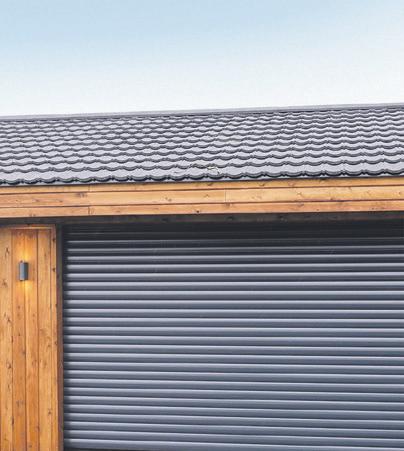

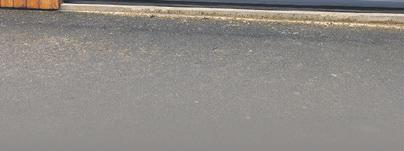
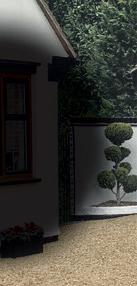



Looking back 60 years to Dr Beeching’s infamous axing of a quarter of the UK’s rail network.
Many of us know the name Dr. Beeching. He has become the track tyrant of a past generation – a man who heartlessly cut a blade through communities in much the same way the rail lines he decommissioned had done through countryside and rural towns.


History will show that the publication of his first report, titled The Reshaping of British Railways, on March 27th 1963, some 60 years ago – and a follow-up two years later – sounded the death knell for a quarter of the UK’s railways, and disconnected overnight a number of towns, villages and hamlets from their neighbours.

In many ways Beeching became the punchbag for arguably one of UK transport’s most sensationally unpopular moves, yet was the label unfair? After all, the railways were in deficit to the tune of up to £100million a year – a wholly unsustainable mass of loss-making lines which were rapidly finding the marvellous motorways a formidable form of competition, as motorcars and freight trucks took footfall away from the trains. Hence, by the time Beeching – a physician and engineer with ICI – was appointed as British Railways chairman in 1961, the network was already in dire straits.
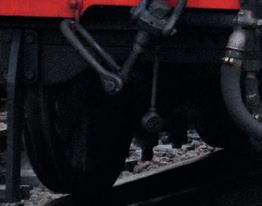
What’s more, the closure of routes had already been happening long before his weighty


report landed with the Ministry of Transport. Three thousand miles of lines had been axed since 1948, so while these new proposals were the most severe yet, they weren’t the first.
A good number of the 2,363 stations and 5,000 miles of track earmarked in the report for closure were in fact given a reprieve, such was the political, social and economic pressure the government found themselves under; and there were also positive recommendations in the report which, for the first time ever, documented a country-wide view of the railway system, and brought about firmer management of lines, operators, passenger welfare and general demand.
Wind forward to today and investment in our railways has never been greater. Network Rail has also worked hard to reinstate rural and local railways - at present there are over 60 Community Rail Partnerships in operation. Not only are these important to the communities they serve, but profitable too!
greater. railways
While it still has a long way to go, Britain’s railway network is once again the fastest growing in Europe and busier now than at any time in the past hundred years. The question has to be asked if this is because of, or despite, the infamous Beeching.




The UK’s cost of living crisis has seen the average household’s energy bill increase to around £3,500, as we experience the highest inflation rates in 40 years, so is it time to turn away from the oven and invest in one of these more energy-efficient cooking appliances?
With up to 10% of your energy bill spent on kitchen appliances, it follows that cooking with more energyefficient appliances could save you hundreds of pounds a year. Here we explore the most efficient alternatives, from the ubiquitous microwave to the humble slow cooker.

When it comes to hobs, much like your oven, gas is cheaper, but electric is more effective.
A lot of heat is lost into the room with gas, but the difference in cost makes the result negligible.


However, an induction hob is incredibly efficient because there is no energy lost around the pan (even electric ceramic plates waste heat), so if induction is an option, go for it.
Microwaves use up to 80% less energy than a conventional oven and cost as little as 8p a day to run. The downside of
course is what you gain in speed and convenience, you lose in versatility. However, it may be worth switching to your microwave when cooking vegetables, pasta and poached eggs, over boiling big pots of water on the hob.

It’s official, slow cookers are back in fashion, and with good reason. Not only have they been found to run on as little energy as a lightbulb, they are also great for feeding a family and can make tough cuts of meat such as beef shin and brisket tender and delicious.
They are also very hands off, meaning you can throw the ingredients in and leave it for hours!
A relatively new invention, air fryers are essentially small convection ovens, making them ideal for small jobs such as cooking frozen fish fingers for your child’s tea or heating up a small pie for lunch.
Also, as the name suggests, the air fryer makes superbly crispy chips with a lot less energy than the oven… and a lot less oil than a traditional fryer.

Pressure cookers can save a huge amount of energy compared to traditional cooking methods, simply because they get the job done so much quicker.
They also make cheap ingredients – low-quality cuts of meat, dried beans and pulses etc. – into meals fit for a king.
The one downside of the pressure cooker is that they take a bit of getting used to, especially as the pressure releasing process can be rather scary!



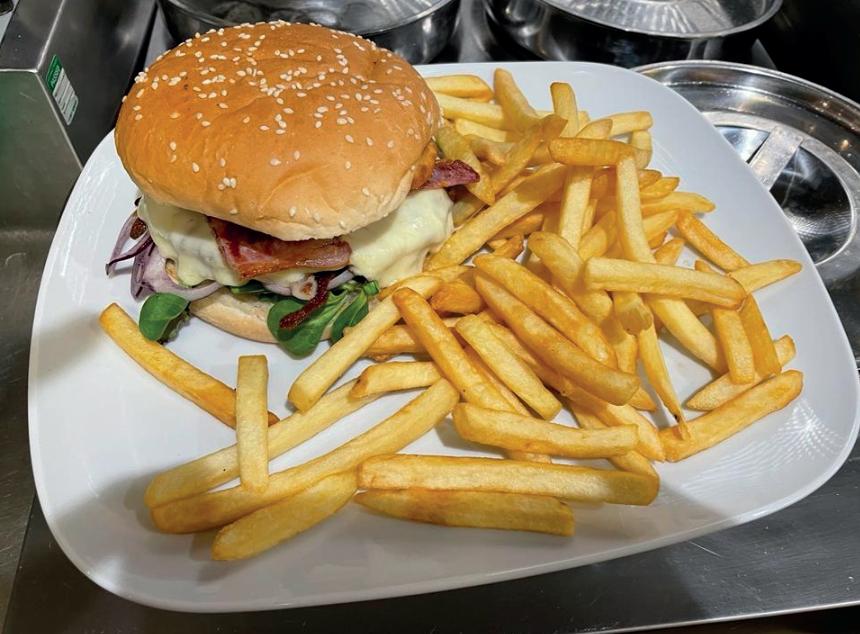

The John Thornton Young Achievers Foundation is fast approaching its 15th Anniversary and the first event to mark the occasion will be a Vintage Afternoon Tea at the Barrington Centre, Ferndown on Saturday 22nd April.

Guests will enjoy dainty sandwiches, scones with jam & Rodda’s Cornish Clotted Cream, cakes and little sweet treats, together with unlimited tea. Our thanks must go to Rodda’s for sponsoring our event.
A scrumptious afternoon tea is not all that is on offer, guests will also be treated to a nostalgic trip down memory with the fabulous ‘Land Girls.’ This talented duo is sure to get everyone singing along as they provide an uplifting 1940’s experience with songs from The Andrews Sisters to Vera Lynn and lots in-between. This is an event not to be missed! Tickets are just £12.50 per person, or £15.00 with a glass of Prosecco,
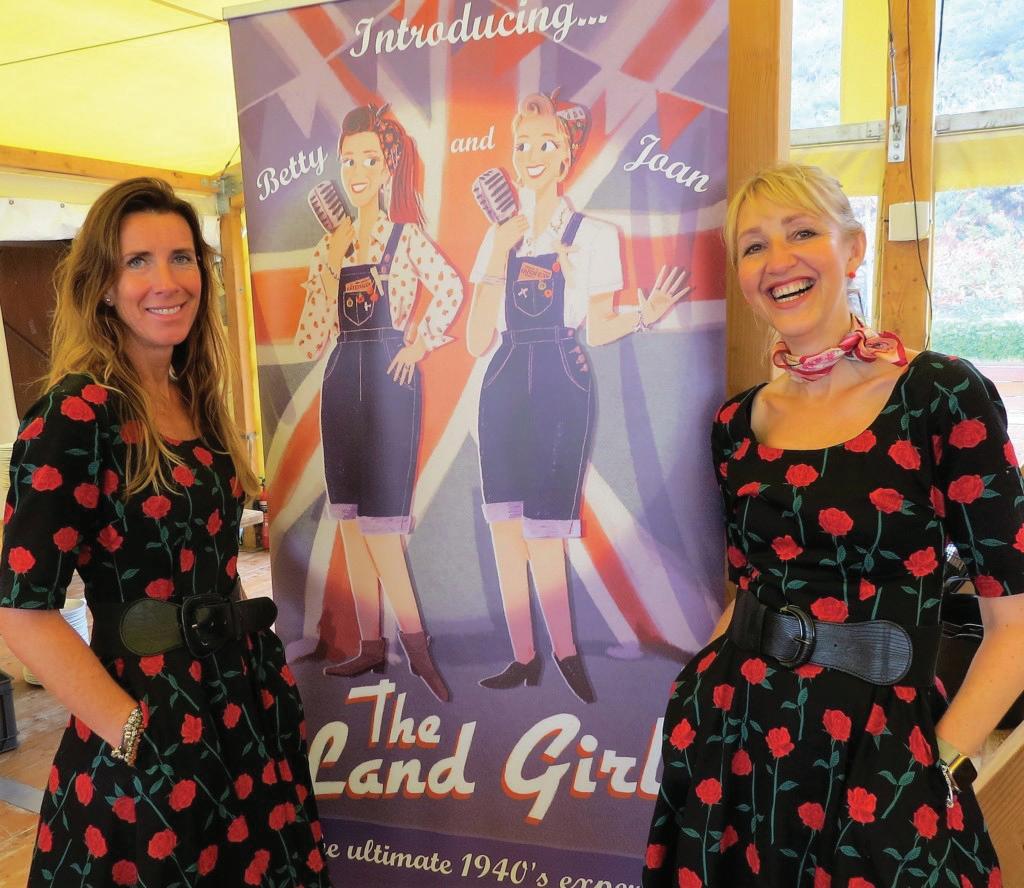
and available direct from the Barrington Centre. Buy yours today, or why not treat someone special?
https://barringtoncentre. co.uk/events
All proceeds will be supporting local young people, providing them with the financial help they need to achieve their ambitions and really develop as individuals. Enjoy a fabulous Vintage Afternoon Tea and support a great local charity in the process.


Thursday 2nd March
Quiz & Meat Draw
Friday 10th March 8:30pm The Reverend
Thursday 16th March

Quiz & Meat Draw
Friday 17th March 8pm

Phil the Power
Sunday 19th March 3pm The Reverend

Sunday 26th March 3pm

Jim Etherington
Thursday 30th March
Quiz & Meat Draw



























How nostalgia revived the record industry.
There are several examples where society finds itself fighting back against the corporate monsters, but perhaps one of the strangest revivals in recent years has been the re-emergence of vinyl records.
At a time when the digital music revolution made listening to our favourite tunes cheaper, instantaneous and effortlessly mobile, we threw value and convenience out the window to reacquaint ourselves with bulky, immobile, dusty, scratch-happy records… but why?
Researchers and scientists believe our connection with music actually hooks into our desire to have physical objects around us, and digital music only ever satisfies one of those emotions.
Vinyl records – and the sleeves they come in – offer something to hold, to read, to savour; while collecting records and building our own ‘project’ through music is said to satisfy that human desire to anchor and look after.
From a low-point in sales terms in 2008, to the five million sold in 2021 offering a 30-year high year, vinyl records now make up 23% of all album sales, proving that our desire to


really immerse in a product and an audio experience is something that is only heading in one direction. Adele sold most vinyl records in
2021, though so in demand was her album, 30, that the 500,000 ordered by Sony created a global shortage in vinyl pressing plants, to the detriment of other upcoming releases. In 2022, the honour of most vinyl sales went to Isle of Wight exports Wet Leg.
Perhaps the most peculiar renaissance in terms of the way we listen to music has come about not through vinyl at all, but a rapid increase in the cassette tape market. In 2021 – the last year for which full figures are available –these totalled 190,000, up a fifth on the total achieved in 2020. What is even more perplexing about the trend is that it’s estimated that over
half of those purchasing cassettes do not even own a cassette player!

Back to vinyl, and it’s not just newly-released music that finds itself in the middle of a dramatic sales flourish, with the second-hand market also proving our desire for physical music continues in an upward pattern (thanks in no small part to sites such eBay and Discogs). Perhaps it’s time to have a look in the attic at some of your forgotten classics, particularly if your collection includes any of the artists below:
The 10 most collectable vinyl artists:
1 Elvis Presley
2 Bob Dylan
3 The Beatles
4 Nirvana
5 Jimi Hendrix
6 Miles Davis
7 Led Zeppelin
8 Beach Boys
9 Metallica
10 Depeche Mode




A new partnership has been announced between Dorset Wildlife Trust and Bournemouth-based ethical consumer brand, Gaia. Dorset Wildlife Trust has been chosen by Gaia as one of the four environmental charities to which the company donates a portion of its members’ fees as part of their commitment to sustainability. As an additional benefit of their membership, Dorset Wildlife Trust members will gain access to a digital Gaia card which offers hundreds of ethical discounts and offers with local and online companies who meet their sustainability criteria.
The donations will go to Dorset Wildlife Trust’s Nature Reserves Fund, the proceeds of which are used to care for and maintain 40 nature reserves across Dorset. These include areas of ancient woodland, wildflower meadows, precious heathlands and wetlands. These are habitats which have become increasingly rare in the wider countryside and are filled with vulnerable species such as the marsh fritillary butterfly, Bechstein’s bat, bee orchid, great crested newt and of course, the Sandwich terns and red squirrels on Brownsea Island.
Dorset Wildlife Trust’s Conservation Director, Andrew Pollard said, “We are delighted to be one of Gaia’s chosen charities. The costs of managing our nature reserves rises every year - restoring rivers, woodlands, heathlands and grasslands, maintaining walking trails, repairing fences required for conservation grazing, and all the work that is required to ensure visitors are kept safe and able to enjoy these amazing wild places. It is an exciting partnership which works for both
our members as well as local companies who care about reducing their environmental impact too”.
Izzy Chalk, Gaia’s Sustainability and Ethics Co-ordinator commented “At Gaia, sustainability lies at the heart of every decision. However, we also understand the pathway to sustainability is complex, with multiple influential factors. This means we need to take action towards environmental stability, social equity, and economic progress simultaneously. In other words, we need to address all 17 of United Nations Sustainable Development Goals. The incredible work carried out by Dorset Wildlife Trust is vital for restoring ecosystems, combating global climate change, and improving the health and wellbeing of society. Therefore, we are thrilled to have Dorset Wildlife Trust as one of our selected charities for our new and improved giving-back scheme, and we are excited to explore how this partnership will benefit both people and the planet”.
To find out more about becoming a member, visit:
dorsetwildlifetrust.org.uk

 Photo: Red squirrel in an apple tree.
Photo: Red squirrel in an apple tree.
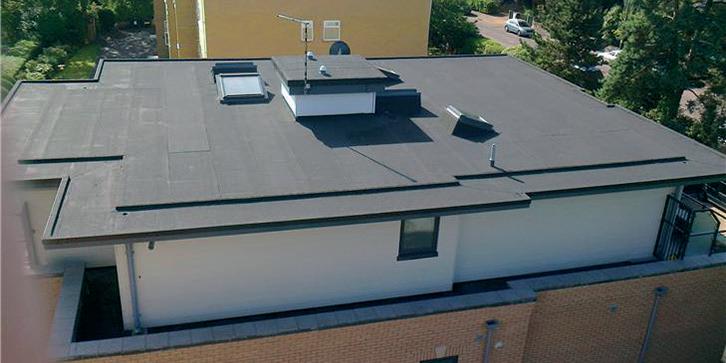






How to stay safe online by avoiding scams, whilst keeping on top of what data you share and with whom.
While technology has made many areas of our everyday lives considerably easier –online banking, shopping and navigation for example – it’s also made us more vulnerable, and often we can underestimate the lengths that others will go to in attempting to obtain our data.
Online scams to look out for Online scams are becoming increasingly sophisticated and even those of us who are skilled at using the internet can be caught out. Scammers sometimes send bogus emails in the hope that people will enter their personal or financial details.


Scam emails can look genuine and appear to be from official places, like HMRC or a bank, but you can often tell it’s a scam. Look out for:
• Errors in the spelling or grammar, or an unusual style of writing
• Requests for personal information, such as your username, full passwords or bank details - genuine organisations will never ask this
• Threats that unless you act now your account will be closed
Occasionally these emails will redirect you to a fake website requesting you to provide personal or financial information. For example, a fake bank website may be set up asking you to update your account or security information. If you have any suspicions, check the URL or type in the bank’s official web address.
Another way of parting you from your well-earned money is via social media or dating apps. Once a scammer has gained your trust, they’ll start asking for money, often by telling you an emotional or hard luck story. If a relationship feels odd, be wary.
How can I protect my data?
• Keep your passwords strong and change them regularly. Use

different passwords for different accounts, avoiding using words or dates that are personal to you and can be found on social media, for example your dog’s name and birth date!
• Install security software on your computer. Anti-virus software will look for and remove viruses before they can infect your computer, while anti-spyware software prevents unwanted adverts from popping up, and stops programs tracking your activities or scanning your computer for private data, such as credit card numbers or bank details.
• Protect your wireless network. Read the instructions that come with your wireless router to find out how to set up a ‘key’ (a type of password) so that no one else can access the internet through your router.
• Keep your device updated. Your device will be better protected from viruses if you keep the operating system updated. You should receive notifications when new updates are available, but you can also update your system manually.


Did you know that your next of kin will not automatically be able to take on your legal rights if you need help because of illness, or mental incapacity?

Your nearest and dearest will only have legal rights if you have given them by making a Lasting Power of Attorney. The people you name to help you must be people you trust to look after you and your money, and you can decide exactly how much authority you give to them.
If you leave it too late, your family won’t be able to access your bank accounts, even to pay for your care, without formal Court authority. We can help you make a Lasting Power of Attorney to protect your interests and give your family any extra authority you think they may need.

We happy to advise we have resumed normal working





hours and are providing onsite visits* again!
*We passed the COVID-19 risk assessment and wear PPE as required for every visit.

I think you know how much we love the sea and outdoor living. Well Daichi was very generous last month and booked us a trip on the MSC (Mediterranean Shipping Company) cruise line, the Grandiosa! We have never been on a ship so big. Oh my, there are enough rooms for up to 6000 passengers as well as several thousand crew. It is magnificent with shops, a chocolate cafe, where they make their own chocolate, restaurants, spa, two theatres, bars and an ice-cream parlour, which of course we had to try… after all it is competition to our own ice-cream and waffle parlour in Weymouth, Wafflicious! I think I am getting a little over excited there… But really it is a splendid vessel. The crew are incredible. From all over the world and each has their own story.
We flew to Rome and got a taxi to Civitavecchia an hour away, where the port is. Staying overnight is a good idea as it takes away the stress of travelling, we find. Especially as this time we were in the plane for three and a half hours before we took off! Better to be safe than sorry though, I would say.
We had a leisurely morning, including coffee and a pain au chocolat at a local bijoux cafe. Just had to be done - we really were now on holiday. Once we were through customs and all the checks were complete, we very excitedly found our cabin and dropped our hand luggage off. The big cases were taken on board
by a crew member. We were on the thirteenth floor! Balcony and all. At 5pm off we set. You can hardly tell you are moving, but at night, being so high up there was an unusual side to side motion which I actually found quite soothing after I got used to it.

Palermo in Sicily! Our first stop. Having never been here before it was a delight to see. Stephen and I decided to take our own tours. The ship does provide great excursions, but we wanted to be independent. Google not only tells you where you can go but also how long it takes to walk there, so we (well actually Stephen) were able to work out exactly what we could do and how much time we had. We walked all the way around the centre of Palermo. The twelfth century cathedral is splendid. The horses and carts are delightful. The Massimo Theatre is glorious. I could really feel the splendour, opulence and dramatic setting of this magnificent Italian town. We so enjoyed our walk, gazing in awe, and of course the coffee sitting in one of the narrow streets complete with small, elaborate balconies and music you could almost hear from times gone by.
Malta was our next stop. After an evening of dining and on-board entertainment, we slowly and majestically arrived at our next destination. My dad was in Malta as part of his two-year conscription many years ago. There is a concept… compulsory enlistment, in his case, into the Royal Navy at the age of eighteen. He remembers it well. Today the
 An ice-cream sundae... Grandiosa style!
An ice-cream sundae... Grandiosa style!
area has many museums and artifacts in memory of the second world war. There are even hidden underground passages you can now visit, that were once used by important military leaders and politicians. Lots to do. We chose again to take our own path and in fact we walked over 20000 steps that day! A glorious walk around Valletta with fantastic views across the bays. The new square surrounded by street food vendors and a really attractive fountain were in contrast to the military background and gave you hope for the future.
A day’s sailing was next on the agenda! We chose to have a spa day and watch a movie while we glided our way through the deep waters of the Mediterranean. So relaxing.
Barcelona in Spain was our next destination. My parents had their honeymoon 59 years ago in this amazing city. As I was born early and 3 weeks less than nine months later, I do laugh and say, “I was made in Barcelona!” La Sagrada Familia is quite a feat. I thought there were building new on top of old and was dismayed, however that is not the case at all. It is still not complete and is the largest unfinished Catholic church in the world. Started in 1882. The new architecture is looking quite splendid and complements to older stones well. I always remembered that mum and dad went to a bull fight all those years ago, so a walk to Plaza de Toros Monumental de Barcelona was a must for me. It is quite an eerie place really. You can walk in the footsteps of both the matadors and the bulls, as well as enter the ring itself. Cultures change and it is interesting to see old traditions and look back on history, where we were and where we have come from.
The next time we got off the ship was at Genoa! Another unknown town to us and one we really

enjoyed walking around. We did not go in the huge aquarium there, but I hear it is highly recommended. Did you know (a bit controversial) that ‘our’ St George’s flag was apparently ‘stolen’ from here? We saw the flag a few times, flying high, and according to Google… “The symbol was adopted by England toward the end of the religious wars, in the 13th century with our ships flying the flag of Genoa as a deterrent to enemies.” Oops… Again, how interesting our history is.
Well, it was time to take our last cruise back to Rome. On disembarking we had a day to explore. Sitting, overlooking the Colosseum having an Italian lunch was awe inspiring. It ended our eight-day, seven night break on a high.


Sailing is not for everyone and certainly I would generally prefer a smaller ship, but we thoroughly enjoyed our self-generated European excursions, coffees in places we had never been before, nights singing to Abba, Italian Opera and the Addams Family in the all-inclusive entertainment each evening. Waited on hand and foot in the restaurants and having as much food as you want in the buffet. We love cruising. Let’s see if Daichi can top that this coming month!
By Debbie Corney A bull’s eye view inside the MonumentalWet weather can really dampen your mood, not to mention interfere with your fashion plans. Here are some waterproof ways to keep on trend when the dark clouds loom.

If you’ve ever worn bootcut jeans or flares, you’ll be familiar with how the loose bottoms drag in puddles and take half the pavement grime home with you. In other words, stick to slim fitting trousers like skinny jeans or leggings tucked into boots. Similarly, a long skirt is going to hold water, so go for something above the knee that you can wear with tights.

Choose high-tech over high fashion
High-end brands like such as Burberry have long been feted for their statement rain macs, but what works on the catwalk doesn’t necessarily work on the school run.
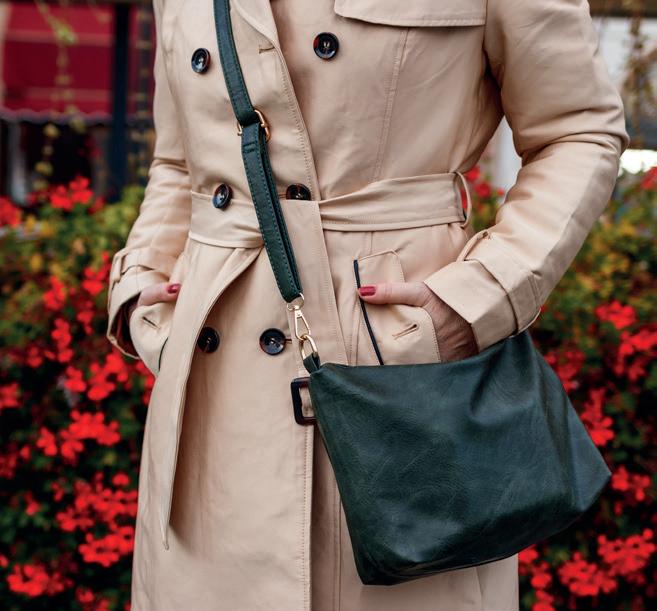

Fortunately, technology enhanced fabrics have been a big focus for the fashion industry the last decade or so, meaning you can find a

raincoat that not only offers almost total dryness, but is also lightweight and flattering too.

The only downside with such materials is that they are manmade and therefore less friendly to the environment. However, many high street brands are now choosing recycled polyester, so it is possible to be dry and a friend of the planet.
Buy some rain booties
I know what you’re thinking: the only time wellington boots are fashionable is when Kate Moss is donning them with a miniskirt at Glastonbury, but these aren’t just any wellington boots. These are the lightweight, Chelsea-boot-style ankle wellies that happen to currently be very much in fashion. That’s right, wellies have upped their style game, and a pair of these beauties tucked into skinny jeans or worn ‘a la Miss. Moss’ with bare legs, will give you that style edge even when the sky is falling in.
If you resent venturing out looking like you’re about to navigate a kayak down a river, then
focus on the small elements of your look that need to be waterproofed. Sturdy, leather boots will keep your feet dry enough in lieu of wellies; a cosy, knitted beanie will protect your hair for a short dash between your car and work; and a practical but stylish crossbody bag that is water-resistant can be big enough for all your essentials, over your expensive, leather handbag.
You may have given up on umbrellas after one gusty adventure too many, but it’s worth bearing in mind that there are brollies available now that are designed to be lightweight, sturdy and wind-resistant.











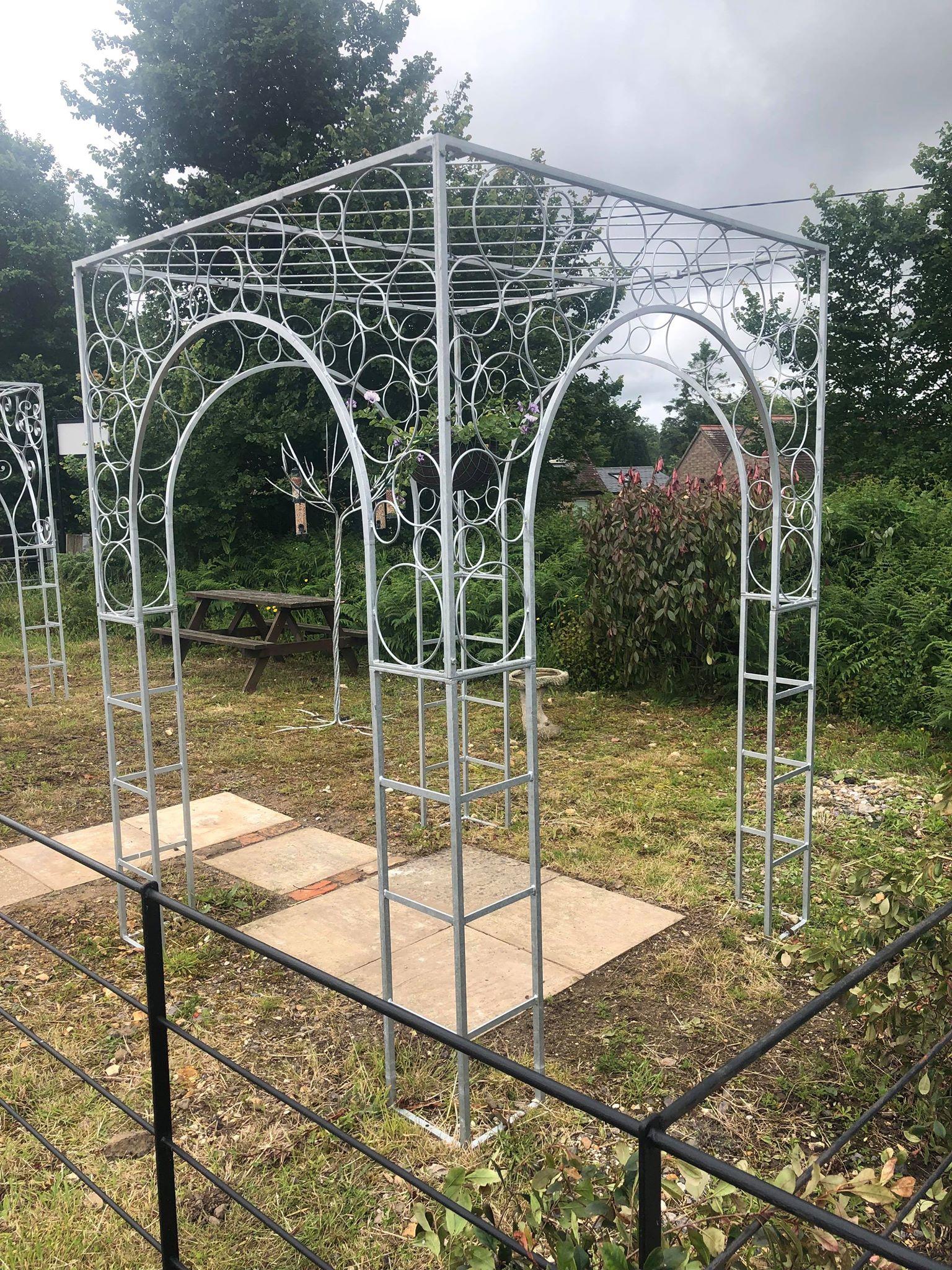




Jamie may be the famous chef in the Oliver household, but his wife Jools certainly has a few tricks up her sleeve, particularly when it comes to creating family-friendly meals, such as this delicious penne.
Created to curb her own pregnancy cravings – the Olivers have a five-strong brood – Jools’ pregnancy pasta is a hearty dish that even the fussiest kids will enjoy.
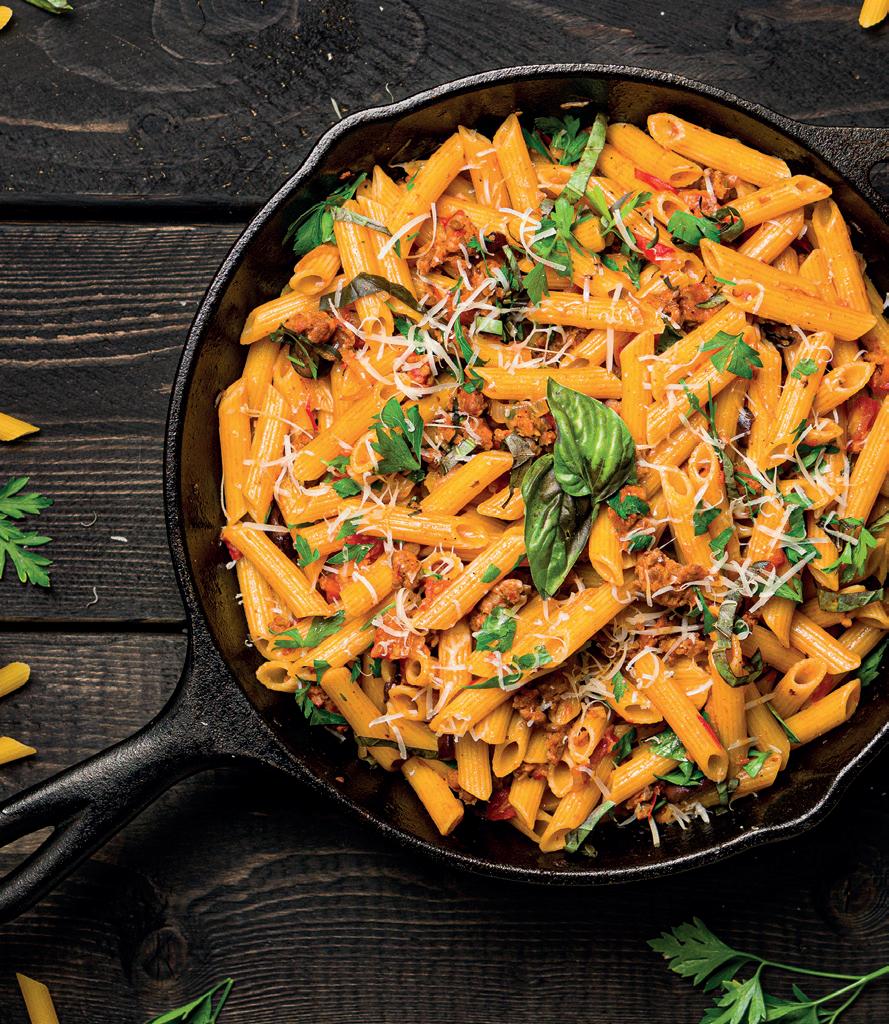
(serves 6)
• 4 spring onions
• 1 carrot
• 1 stick of celery
• 1 tsp chopped fresh red chillies
• 400g good-quality sausages

• 500g dried penne
• 1 tsp fennel seeds
• 1 tsp dried oregano
• 4 garlic cloves
• 4 tbsp balsamic vinegar

• 400g chopped tomatoes
• a few sprigs of basil
• Parmesan to serve
The key to cooking flavoursome pasta is to properly salt the water that you cook it in and be sure not to overboil it. The pasta should have a slight bite to it. Also, do no miss out reserving a cup of the pasta water for mixing with the sauce at the end; this emulsifies the pasta making it velvety and delicious.
1. Get all your ingredients and equipment ready. Fill and boil the kettle. Put a large frying pan on a high heat. Put the standard blade attachment into the food processor.
2. Trim the spring onions, carrot and celery. Roughly chop all the vegetables, then blitz in the food processor with the chillies (stalks removed). Add the sausages, a heaped teaspoon of fennel seeds and one teaspoon of oregano. Keep pulsing until well mixed, then spoon this mixture into the hot frying pan with a lug of olive oil, breaking it up and stirring as you go.
3. Put a large deep saucepan on a low heat and fill with boiled water. Fill and re-boil the kettle, then top up the saucepan with more boiled water if needed. Season well, then add the penne and cook according to packet
instructions, with the lid askew. Drain the pasta, reserving a cup of the cooking water.
4. Crush the cloves of garlic into the sausage mixture and stir in the balsamic vinegar and tinned tomatoes. Add a little of the starchy cooking water from the pasta to loosen if needed.
3. Tip the pasta into the pan of sauce and give it a gentle stir, adding enough of the cooking water to bring it to a silky consistency. Taste, correct the seasoning, then tip into a large serving bowl and take straight to the table with the rest of the Parmesan for grating over. Scatter over a few basil leaves.
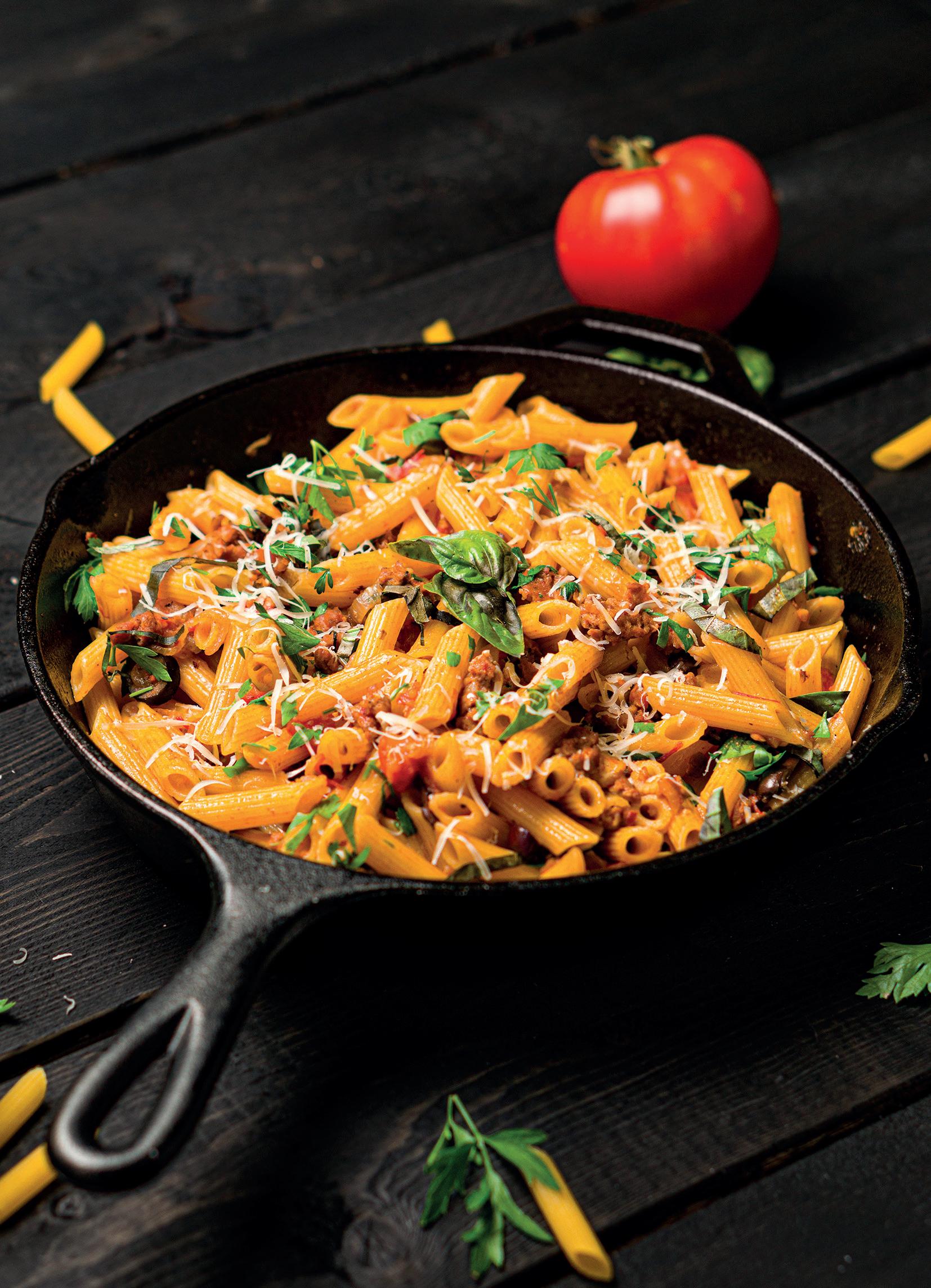
How our perception of diesel has changed over time, and why this final downward turn seems to finally be sounding the death knell for the petroleum product once labelled ‘wonderfuel’.
In the 1990s, life was beautiful for diesel. Engine technology improved with every passing year; and while fuel prices were low, supply was buoyant and, as a result, the popularity of this petrol derivative boomed.
The ‘wonderfuel’ revolution permeated the mass market of car production. Rather than an earthy, dirty oil that was once only associated with trucks, coaches and industrial machinery, diesel had funnelled itself through a centre space of transport where it propelled the ambitions of family cars, nippy run-arounds and souped up superpowered showpieces.
The boom has been down to the realisation that costeffective performance wasn’t just something that should be exclusive to the commercial vehicle operator, and cars such as the Audi 100 pioneered electronic control of the diesel engine for the first time. This advancement did huge things in terms of emissions, refinement and power; with the engines themselves benefitting from much greater power density thanks to tighter tolerance and improvements in fuel injection technology.
The marketing plan lasted a generation before the first chinks in the armoury were spotted. They arrived in
2015 and came bundled up as full-on warfare in light of the VW emissions scandal, although three years previously scientists spoke of the “silent killers” that particulate matter (PM) and NOx (nitrogen oxides and oxides) were proving to be.
Rapidly, diesel exhaust was declared a carcinogenic which put it in the same category as mustard gas and asbestos, causing lung cancer, and investment was backtracked. The Mexico City, Athens, Paris and Madrid mayors all pledged to outlaw diesel cars from city centres by 2025. Meanwhile London accelerated its commitment to low-emission

zones, as well as imposing strongly prohibitive toll charges designed to quell the diesel storm.

In 2023, the directive now is not to reconfigure, repackage or reduce, but to cease the production of diesel vehicles altogether. After all, fuel and maintenance costs are far lower with EVs and hybrids – the vehicles have fewer working parts needing to be fixed or replaced – and while the global energy crisis is rapidly pushing up the cost of utilities, its price elevation is no worse than that of fossil fuels.

The death knell has sounded, and with it comes frustration that the promises of diesel’s longevity – where motorists would complete a life cycle of car purchases – have turned out to be false.




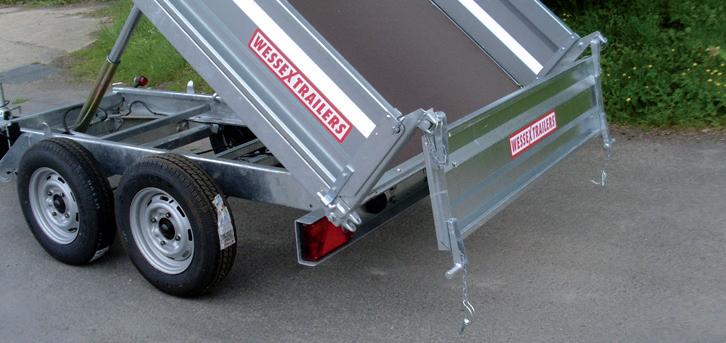




























































ANTIQUES • VINTAGE • COLLECTABLES • CRAFT
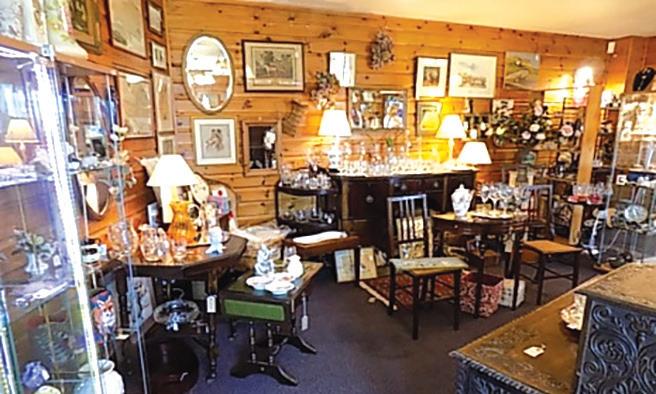
OVER 60 TRADERS • CAFE • GARDEN CENTRE
DOG FRIENDLY • FREE PARKING • WHEELCHAIR ACCESSIBLE
A37 DORCHESTER – YEOVIL • DT2 9PW
OPEN MON – SAT 9-5 / SUN 9-4


SPACE AVAILABLE TO RENT • TEL: 01935 83069 FIND US ON FACEBOOK

Rear set colour coded: from £160
Front set colour coded: from £190


Both Front & Rear Sensors: from £280 CRUISE CONTROL FOR MOST VEHICLES £425 FIT TED PRICE.






Metatrak insurance approved vehicle £330

Rear view cameras for Cars £190, Vans from £225 & Motorhomes from £245
Dash cameras starting at £145 or FRONT & REAR cameras for just £245



He’s a brilliant presenter, accomplished gardener, talented novelist, and allround horticultural inspiration. This month, Alan Titchmarsh discusses garden design and spontaneity.

They say that a builder’s home is always unfinished, and much the same is true of any gardener in regards to his or her outside space.
We have been in our current home for almost 20 years, and I am still evolving, adding, altering – every day. And that’s what makes each passing year so special – the fact you never go back to a blank canvas, but each spring there are new opportunities, ideas and spaces that emerge here and there, that can be formed into whatever takes your fancy at that particular time.
While variety and versatility are definitely important in a garden, I do find it’s necessary to follow some familiar boundaries. One
of those, for me, is to ensure the inspiration for the style of my garden comes from the feel of my house, and I think this is true for any

outside space. The two must complement each other or you may find you end up with an awkward juxtaposition between the building and nature.
So my property is a classic, square Georgian farmhousethus I felt I had to do something that complemented that in the garden. I like straight lines anyway, which cross each other, and have softened this by planting throughout, creating a sort of billowing chaos in beds and borders. You essentially have one giving structure to the other.
Remember, gardening is very different to
architecture, because what you are dealing with isn’t just shape and form, it’s time as well –it’s a rapid adjustment and change between how something looks on day one and how it will look on day 100.
And while I know you’ll hear gardeners talking all the time about planning out an area, the types of plants you’ll have, and the tone and feel of a space; very often the reality is you are inspired by something off the cuff, and it is that instinctive appeal that’s exciting.
Whatever you’re going to do in your garden space, I would suggest it is gradual and over time. It really pays to observe and watch how nature embraces things – see what grows and what outgrows, and only when you are absolutely sure you want to adjust a certain area, only then proceed.

It’s about a steady progression rather than the wholesale demolition… such is life!













Eight top tips to help parents nurture and encourage their children with their weekly homework.

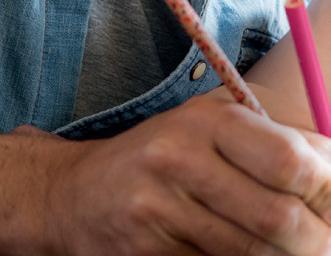

It may feel like a lifetime since your own school days, but providing proper support for your child as they navigate their homework is not only beneficial for them, it’s also highly rewarding for you as a parent. And who knows, you might even learn a thing or two in the process.
1. Create a study space
If you don’t have the room for a dedicated desk, commit to a certain period of every evening where your child can have the use of the kitchen table. Either way, a comfortable, well-lit area with access to stationery, pencils and a plug socket will help create the best atmosphere for learning.
2. Limit distractions
Commit to a period every evening of no phones, TV or music, during which your child can entirely focus on the job at hand.
3. Establish a routine

All kids are different, so figure out what period after school is best for your youngster to concentrate. Some will prefer to crack on straight away when they get home, whereas other will want to relax and have dinner before resuming schoolwork. Whatever it is, once you find a rhythm, stick with it.
4. Set an example
Whether it’s organising your monthly budget or time spent reading a book, it helps for kids to see their parents ‘doing’ rather than just ‘telling’.
5. Motivate Engage with what your child is doing and help make it fun. Maybe you could create some fun quizzes or games - both proven ways to help information retention.
6. Don’t do it for them
Tempting though it may be to demonstrate your academic prowess, it is important to make sure your youngsters are thinking for themselves and,
at the same time, learning from their mistakes.
7. Engage with teachers and other parents
Understanding what your child’s teacher expects from them will help you guide their homework. Also, it can be helpful to communicate with other parents who may be able to reassure you that all children have certain areas of learning where they struggle and others where they thrive. And don’t be afraid to seek additional assistance if you feel your child needs it.
8. Rewards and praise
If your child exhibits real enthusiasm and determination, it is vital that you reward them. Arrange for a special treat if they get a certain grade or achievement, and make a fuss of them by informing family and friends of their ongoing success.











































Across Clues:
1. Brandenburg Gate is here (6)
5. Sadden (6)
10. White fleshed nut (7)



11. To surrender (7)

12. Preoccupy (6)

14. Permanent artwork (6)
15. Take action (3)
16. Plant with large flowers (4)
19. Young insect (4)
20. Of crucial importance (7)
21. Small wingless insect (4)
23. Fail (4)
27. Time of existence (3)
29. Surviving (6)
30. View films (6)
33. Rail-like wading bird (7)
34. Indigenous lore; fundamental life force (7)
35. Sin of ___ meaning lack of care. (6)
36. Measure the volume (7)
Down Clues:
2. Deferral (7)
3. Woolly (6)
4. Short letter (4)
5. Saucer (4)
6. New layer (6)


7. Moving fluid in an enclosed line (7)
8. Institution (6)
9. Soak (6)
13. Selfish person (7)
17. Strike (3)
18. Cereal grain (3)
21. Lacking physical strength (6)
22. Relating to insects (7)
24. Tendency to do nothing (7)
25. Act (7)
26. Past; long and thin reptile (6)
28. Small seal (6)
31. Russian beauty working for the KGB (4)
32. Leave out

Welcome to the March Stargazing Page. Highlights this month include a close meeting of the brightest planets in the Solar System and Orion the Hunter still visible high in the southwest.
The ISS can be spotted early in the morning until the 11th. Viewing then switches to our evening skies from the 16th. To establish exact timings please refer to www.heavens-above.com or a similar webpage for up-to-date information, remembering to set the location to your observing area.
Venus and Jupiter appear extremely close to one another (known as a conjunction) in the early evening western sky. The closest they reach is on March 1st, after which the planets will slowly separate. This conjunction can easily be seen with the naked eye, but a pair of good, steady binoculars may allow you to spot some of the moons of Jupiter.
The start of longer daylight hours commences on March 20th at the Spring Equinox. This marks the first of two dates (the second being the Autumn Equinox) when daylight hours equal the number of night-time hours, wherever you are on Earth (equinox comes from the Latin meaning ‘equal night’). The equinoxes are the best time of year to determine the main compass point directions relative to your own home, as the Sun rises due east, sets due west, and is due south at midday. Try remembering these positions relative to a building or a tree.
Moon
March’s full moon occurs on the 7th.
The innermost planet is too close to the Sun to be seen this month.
Venus
Venus continues to dazzle in the southwest every evening and will be impossible to miss! At the start of March it sets around 8.30pm, but by month end it is sinking below the horizon as late as 11pm. It is close to the Moon on the 23rd and 24th (see figure).
Mars
The red planet can be seen above the constellation of Orion until the early hours of the morning, and although getting dimmer every day, is still a bright object.
As the Sun sets, Jupiter is visible low towards the southwest. By the end of the month it will be lost in the Sun’s glare. Saturn is too close to the Sun to be visible this month.
Diagonally across from Rigel, February’s Star of the Month, we find Betelgeuse, the tenth brightest star in the sky. It marks the right shoulder of Orion the Hunter, and its name stems from the Arabic for ‘hand of Orion’ (see figure). It is a red supergiant that is much cooler than our Sun; its surface temperature is 3,500°C. Betelgeuse is an enormous star at the end of its life, and if it were to replace our Sun at the centre of the Solar System, its surface would extend to at least the orbit of Mars. Put another way, if the Sun were the size of a grapefruit, then Betelgeuse would be the size of a large football stadium. Like Rigel, it will end its life in a giant explosion known as a supernova, leaving behind a neutron star or a black hole. On a night with no moon, see if you can notice that Betelgeuse is noticeably more orange than nearby stars.
The trend for upcycling raw materials into garden furniture is coming to a back garden near you.
It’s the time of year when we all begin to consider ways we might be able to spruce up our gardens in time for the summer.
Of course, while plants, flowers, produce and more is a necessity for giving our outside space that natural, living, thriving edge, there’s an entire other aspect that will contribute towards the comfort and convenience of your garden, irrespective of its size. And while upsizing an old pallet into the ultimate outdoors DIY sofa may not scream opulence, the trend for creating fantastic homemade furniture for outdoors is one that’s really gathered pace in recent years.
THE DIY SOFA
What you’ll need:
• Three (or more) plain wooden pallets
• An electric drill with screws
• A small roller and tray
• A paintbrush
• Scatter cushions
• Garden furniture chalk paint
How to make your pallet sofa:
1. Using your foam roller, layer your pallets in whichever glorious hue you have selected, using a paintbrush for those tricky to reach areas. Paint one side first, let it dry, then do the other.
2. You’ll need to stack at least two pallets to get your sofa to a suitable height – you may want to make your sofa higher using more pallets, or even double the length... it’s all up to you! – before fixing them together with your electric drill and screws.
3. Add another pallet to the back of the bench to make your sofa back. Affix with screws.
4. That’s the hard part done! Now decorate your masterpiece in whichever way you choose with cushions, garlands and
throws. Then relax… you’ve earned it!
Advantages of using pallets for furniture
1. Cost-saving

By using your creativity, you can capitalise on a raw material – wooden pallets – that most people give away for free.

2. Environmentally friendly With furniture made from pallets, it’s as environmentally friendly on its way out as it is in its creation as an arty piece of reclaimed wood.
3. A design for garden life
By creating your own furniture rather than buying it, you are able to put your imprint on the look, so complete customisation is merely a few planks of wood away!
4. Mature with age
life are being
After two or three years, outdoor furniture can show the effects of being weatherbeaten, yet with pallets the resplendent ruggedness only adds to the effect!
























Famed for the gigantic, raspberrydusted meringues that adorn his shop windows, Yotam Ottolenghi is a patisserie expert, and these deliriously fudgy cookies are no exception.


(makes 24 cookies)
• 110g unsalted butter at room temperature, cubed
• 110g caster sugar
• 1 large egg, lightly beaten
• 125g plain flour
• ½ tsp baking powder
• 20g cocoa powder
• ½ tsp ground cinnamon
• ¼ tsp salt
• 100g 70% cocoa chocolate chips (or 100g dark cooking chocolate in 0.5cm pieces)
• 50g mashed banana (½ small banana)
• 170g pecan halves, finely chopped
• 100g icing sugar
1. In the bowl of an electric mixer with the paddle attachment in place, beat the butter and sugar on a mediumhigh speed until light and fluffy, then add the egg and beat to combine.
Sift the flour, baking powder, cocoa powder, cinnamon and salt into a bowl, then add to the

butter mix, beating on low speed for 15 seconds. Now beat in the chocolate and banana until combined, then transfer to the fridge for two hours to firm up.
2. Once firm, form the dough into 24 3cm balls, about 20g each. Put the pecans in a bowl, then drop in each ball, rolling it around to coat, which will press the nuts in as well, so they stick.
Put the cookies on a baking tray lined with greaseproof paper and refrigerate for at least an hour.
3. Heat the oven to 190°C/375°F/gas mark 5 and
line two oven trays with baking paper. Put the icing sugar in a bowl and roll the cookies one by one in the sugar, pressing it in as you go, so it sticks. Arrange the cookies on the trays 2-3cm apart, then flatten them to about 1cm thick.
4. Bake for 10 minutes, then remove: the cookies will be soft to the touch. Leave to cool for 10 minutes, then move to a rack. Serve warm or cool.


Maintain that fudgy factor by ensuring you don’t overbake these cookies.
You can also freeze them for up to three months once you have rolled them in to balls. Simply add one extra minute on to the baking time when you are ready to use them.









